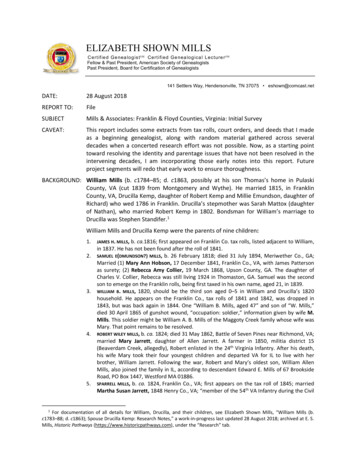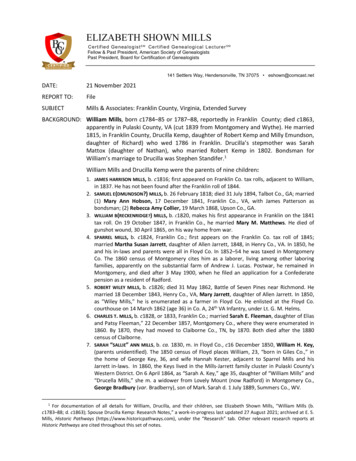
Transcription
OPERATING INSTRUCTIONS FORMILLS AND FLAKERS
For more than 30 yearsWe would like to thank you and are glad that you have decided to purchase a product from our company. You will enjoyyour solid device for a long time, since it has been produced by hand with an impressive love for the detail from bestmaterials. Please thoroughly read these operating instructions before using the device for the first time. There you willfind all information for a safe operation.We wish you to enjoy preparing your fine dishesMarcel and Peter Koidl2
3
Safety instructions for KoModevices1. Please thoroughly read the operatinginstructions and follow the included notes.2. Connect your electrical device only to a suitablepower socket. Check if the data which are indicated ontype plate comply with your power grid. Do not use anymultiple plugs or extension cables.3. Only use the device if all associated parts arein perfect condition.6. Our devices are engineered for grinding of normalhousehold quantities of corn to flour, flakes and gristand it is not intended for commercial use. The exceptionare our professional devices.7. They must only be operated by adults whoare physically and mentally able to operate thedevices and who have completely read theseinstructions.8. Switch your device off when it is no longer used.4. Only use purified raw food. Non-purified raw foodoften contains small stones and impurities, which mightdamage the device.9. Before opening the device the power linemust always be disconnected! Risk of injury bymobile parts and risk of entrapment!5. Your KoMo device is mainly made ofwood. This material reacts on environmentalinfluences. Climate and temperaturefluctuations might result in small fractures. This doesnot impair the function. Do not place the device inproximity to radiators or the stove and avoid places withdirect solar radiation in order to protect the housing atthe best.10. Place your device during use on a hard support (e.g.a kitchen counter). It will guarantee that the slots at thebottom of the device will be free to ventilate the motor.411. Do not use the device outside, in humidrooms or nearby open water containers. Thedevice must not get wet.
12. Make sure to collect the grist or flakes with asufficiently large container, so that the grist or flakes donot get jammed in the outlet.13. Before using the device, check with the overview ofgrist in the attached brochure or under www.komo.bio,if the device is suitable for the desired raw food.14. Insofar as the device is screwed togetherand can only be opened with tools, only ourcustomer service is allowed to open it. In caseof disregard, the warranty becomes null and void. Notools are required for cleaning. This applies except forthe disassembly of the millstones for maintenance andcleaning purposes. Observe the instructions in thismanual for the disassembly.16. If the power cable of the device wouldget damaged, it needs to be replaced bythe manufacturer, his customer service or aqualified person.17. Keep the device away from liquids, heat, openflames and humid rooms.18. The manufacturer cannot be held liable fordamages, which are caused by improper use or wrongoperation.19. Never leave the appliance unattended duringoperation.15. Do not use the cable to pull the plug out of thesocket, but directly pull on the plug and do not placethe cable on sharp edges.5
General operation of theflakerWhat materials can be crushed?Oat, rye, wheat, buckwheat, millet, barley, spelt, unripespelt grain, rice, sesame, flax seeds, poppy seeds as wellas spices such as caraway seeds, pepper or fennel. Thisis only a small choice, this list is continuously extendedand its latest version can always be found under www.komo.bio.Flakes The flakes need to be well purified, otherwiseit might result in damages of the device byimpurities such as e.g. stones. Fresh oat flakes should be immediatelyconsumed, since they rapidlyloose valuable nutrients when storing them andmight taste bitter.6 We recommend oat without spelt (non-hulled oat) forflaking. Briefly moisten other grain varieties in astrainer, let them dry for a few hours and thenflake them. Otherwise they would crumblewhen flaking them and they will be more digestibleafter leaving them to soak.
OperationFlocinoAssembly1. Fix the flaker to a table plate or similar means with thehelp of the two screw clamps.2. Then turn the hand crank clockwise.3. Finally put on the hopper with the adapter piece andthe hopper lid.Instructions1. Place a container underneath the device.2. Fill flakes (e.g. non-hulled oat) into the hopper.3. Turn the crank clockwise.4. If required adjust the flake thickness with theadjusting screw. To do so, the flaker needs to be empty.Disassembly1. Disassemble the jacket below the flaker, by shiftingthem to the side and removing them.2. Block the rollers from the bottom user the wedgewhich is included in the delivery volume.3. Disassemble the crank by turning it counterclockwise.Cleaning1. Optional - Disassemble the Flocino from the tableplate.2. Disassemble the jacket below the flaker, by shiftingthem to the side and removing them.Do not reach with the fingers into the rotatingrollers. Danger of getting jammed!3. Clean the rollers with a brush or a cloth. At the sametime, move the rollers by turning the crank.CareThe Flocino is made of solid beech andsynthetic material free from BPA and finishedwith vegetable oils The regular care can beperformed with a dry or humid cloth. If there are signsof wear after some time, you can lightly sand the woodand coat it with e.g. boiled linseed oil, which is availablein the specialist trade.7
OperationFlicFlocAssembly1. Fix the flaker to a table plate or similar means with thehelp of the two screw clamps.2. Then turn the hand crank clockwise.3. Insert a steel sheet into the gap with the FlicFloc labelshowing upwards.Instructions1. Place the glass which is included in the deliveryvolume underneath the device.2. Fill flakes (e.g. non-hulled oat) into the hopper.3. Turn the crank.The flaker is set in a way that it can crush corn as wellas oilseeds. Thanks to the FlicFloc technique it is notnecessary to set the thickness of the flakes .Disassembly1. Block the rollers from the bottom user the wedgewhich is included in the delivery volume.2. Disassemble the crank by turning it counterclockwise.CareCleaning1. Pull the steel sheet with the logo upwards in order toremove it.Do not reach with the fingers into the rotating rollers.Danger of getting jammed!2. Clean the rollers with a brush or a cloth. Atthe same time, move the rollers by turning thecrank.8The housing is made of beech Multiplex andfinished with vegetable oils. The regular carecan be performed with a dry or humid cloth.If there are signs of wear after some time, you can coatit with e.g. boiled linseed oil, which is available in thespecialist trade.
OperationElectric flakerInstructions1. Connect the device.Never reach into the flakes. Danger of gettingjammed.2. Place a container underneath the device.3. Fill flakes (e.g. non-hulled oat) into the hopper.4. Switch on the device,TIP: If required, it is possible to adapt the flakethickness by turning the adjusting knob. Todo so, remove the front plate and empty theflaker.5. Switch off the device after the flaking process.Cleaning1. Disconnect the device.2. Remove the front plate.3. Remove the flaker to the front.4. Clean the flaker with a cloth or a brush with flowingwater and dry it before reassembling the device.5. When reassembling,make sure that the coupling behind the flakeris neatly inserted.CareThe housing is made of solid beech Multiplex andfinished with vegetable oils. The regular carecan be performed with a dry or humid cloth.If there are signs of wear after some time, youcan coat it with e.g. boiled linseed oil, which is availablein the specialist trade.9
General operation of the millsWhat materials can be ground?Wheat, oat, spelt, buckwheat, rice, barley, millet, unripespelt grain, corn, coffee, lots of spices such as carawayseeds, pepper, coriander, anise or fennel. This is only asmall choice, this list is continuously extended and itslatest version can always be found under www.komo.bio.Grist The grist needs to be well purified, otherwiseit might result in damages of the device byimpurities such as e.g. stones. To avoid moths and insects when you do not use themill, you can put a tea bag with herbal tea or laurel leafsinto the outlet or into the milling chamber. Grind your flour only once, it is not possible to increasethe fineness by grinding it several times, but themillstones would smear. In particular when grinding hard corn such as riceor maize, put the grist into the funnel while the mill isswitched on and do not interrupt the grinding process. Always keep your grist in a dry place. If the grist is toohumid, either place it in a linen bag beside the heaterfor a longer time or put it on a baking tray in the oven at50 C for half an hour. The drier the grist, the finer is the ground product andthe cooler is the flour.TIP: Test the humidity by crushing one cornwith a spoon on a smooth surface. If the corncracks, it is dry enough. If it crushes like an oatflake it is too humid.10
Operation of the manual millAssembly1. Fix the mill to a table plate or similar means with thehelp of the two screw clamps.2. Then turn the hand crank clockwise.3. Finally put on the hopper with the adapter piece andthe hopper lid.Instructions1. Place the tray, which is included in the deliveryvolume, underneath the device.2. Fill the grist into the hopper.3. Turn the crank clockwise.4. If required, adjust the fineness of the flour by settingthe adjusting screw. To do so, either simultaneously turnthe crank or empty the grinder.CleaningIt is not necessary to clean the mill separately, if it isbeing used as intended. However, if the millstoneswould smear due to e.g. wrong, humid or oily grist,please proceed as follows:1. Turn the fine adjustment to medium to coarse.2. Turn the crank until the grinder is empty.3. Fill in about 2 handful of long grain rice and grind itwith the adjustment medium to coarse.DisassemblyGenerally, it is not necessary to disassemble the mill.However, if it should be necessary, please observe thefollowing instructions:1. Have the device fixed to the table.2. Take off the hopper with the small connection pipe.3. Set the fine adjustment to coarse.4. Turn out the two screws counter-clockwise with anAllen key.5. Pull off the side part with the adjusting knob to therear.6. Carefully remove the plexiglass tube.7. You can clean the millstones with a hard brush, neveruse a humid or wet brush.8. Assemble the mill in reverse order.9. Tighten the screws uniformly but not too firmly.3. Set the adjustmentknob to coarse4. Unscrewthe screws5. Pull off theside partCareThe hand mill is made of solid maple and thesurface is lacquered. Therefore, it is sufficientto clean it with a dry or humid cloth.11
Operation of theelectrical mill12
Instructions1. Connect the device.2. Place a container underneath the device.3. Switch on the device,4. Adjust the desired fineness by turning the hopper.TIP: Set the finest adjustment by turning thehopper without grist to the direction Fine whilethe mill is running until you can hear how themillstones are grinding on one another. Then, turn a littlebit to the direction Coarse, until the grinding noise stopsand you have found the finest setting!5. Fill the grist into the hopper.6. If required, readjust the fineness by turning the hoppereither while the grinder is empty or while grinding.7. Switch off the device after the grinding process.CleaningIt is not necessary to clean the mill separately, if it isbeing used as intended. However, if the millstoneswould smear due to e.g. wrong, humid or oily grist,please proceed as follows:1. Set the fine adjustment to Coarse by turning thehopper.2. Fill in about 2 handful of long grain rice and grind it.3. Repeat this process, if the mill is heavily soiled.4. Before a longer standstill, it is recommended toproceed as described above while holding a vacuumcleaner to the outlet and to the open lid, in order toremove all flour residues.DisassemblyGenerally, it should not be necessary to open themilling chamber, but when necessary, please observethe following instructions:1. Disconnect the device.2. Turn the hopper as long to the directionCoarse (counter-clockwise), until you canremove the hopper.3. Remove the upper millstone.4. Clean the milling chamber with a cloth or brush anddry the millstones with a hard brush as required, neveruse a wet or humid brush.CareThe housing is made of solid beech or ofMultiplex beech and finished with vegetableoils. The regular care can be performed with adry or humid cloth. If there are signs of wear after sometime, you can coat it with e.g. boiled linseed oil, which isavailable in the specialist trade.13
OperationCombined devicesOur combined devices are a combination of ourmills and flakers. Please find the description for thecorresponding devices in the following chapters: FidiFloc: Electrical mill, FlicFloc, see notes below Duett: Electrical mill, electrical flakerFidiFloc:Remover the flaker1. Disconnect the device.2. Turn the hopper as long to the directionCoarse (counter-clockwise), until you canremove the hopper.3. Pull the cover above the flaker to the right and lift itoff.4. Unscrew the crank from the flaker. To do so, block therollers at the bottom with the wedge which is includedin the delivery.5. Loosen the white screw counter-clockwise with thefingers.6. Remove the flaker by pulling it upwards.whitescrew3. Take off the cover4., 5. Remove the crank,loosen the screw146. Lift out the flaker.
OperationFlour sifterInstructionsFlour of all grain varieties such as wheat, rice, maize, etc.can be sifted.However, it is not possible to sift e.g. oil seeds or nuts,otherwise the sifters would smear.Mounting the flour sifter onto the mill:1. Switch off the device.2. Turn the hopper of the mill as long to thedirection Coarse (counter-clockwise), until youcan remove the hopper.3. Remove the upper millstone.4. Put the white plastic ring to the position of the uppermillstone, refer to the illustration.6. Screw the flour sifter instead of the hopper on themill by turning it once.7. Switch on the mill.8. Turn the flour sifter as long to the direction Fine untilthe brushes start turning.9. Turn another quarter of a turn to the direction Fine.10. Switch off the mill.11. Put the grist into the flour sifter.12. Put on the lid.13. Place a blow underneath the outlet.14. Switch on the mill.15. Switch off the mill as soon as the flour is sifted.16. Remove the flour sifter after use by turning itcounter-clockwise.TIP: Always retain the flour sifter on the wooden basewhen turning it; never retain the plexiglass tube.5. Put the plexiglass cylinder on the bottom part of theflour sifter. At this, two balls will cam in the indentationsof the cylinder. To that, turn the cylinder a little bit, ifnecessary.15
Replacing the sifter1. Remove the flour sifter after use by retaining thewooden base and turning it counter-clockwise.2. Remove the plexiglass cylinder from the flour sifterwith a slight jerk upwards.3. Unscrew the brush holder, to do so, turn the whiteplastic disc clockwise (left-handed thread!) whilelocking the bottom part.4. Replace the sifter; make sure that the flat side of theplastic ring in the centre is positioned upwards (Illustr.5).5. Retighten the brush seat by hand.6. Reposition the plastic glass cylinder; at this, the 2balls will cam in the in the indentations of the cylinder(Illustr. 6).2. Removethe cylinder3. Unscrew theretainer163. Removethe retainer4. Replacethe sifter5. Plasticring6. Cam inthe ball
OperationInterchangeablemilling systemInstructions1. Disconnect the device.2. Turn the hopper of the mill as long to thedirection Coarse (counter-clockwise), untilyou can remove the hopper.3. Remove the upper millstone.4. Retain the bottom millstone and screw off the screw inthe centre clockwise with the Allen key which is included inthe delivery (left-handed thread!); in doing so, also removethe disc and the block.5. Uniformly drag the bottom millstone upwards with thewire which is included in the delivery and remove it; indoing so, the brush of the millstone should be positionedin direction of the outlet.6. Clean the milling chamber and the outlet with the brush.7. Insert the milling chamber insert, starting from theoutlet.8. Insert the bottom replacement millstone with the disc,block and screw and tighten it counter-clockwise by hand.9. Put on the upper replacement millstone.10. Mount the hopper.11. Perform the fine adjustment as described in theoperating instructions of the mill, in order to find out thefinest adjustment (it might deviate from the original setpoint).12. Set the desired grinding degree.13. For details regarding the commissioning or fineadjustment, refer to the chapter “Operation of theelectrical mill”.6.7.8.17
TroubleshootingThe motor is humming, but the mill does notstart up.Turn the setting to Coarse, until the mill starts up. Thenset the desired degree of fineness.The mill stops during operation.Switching off due to overheating only takes place incase of overload. In this case, disconnect the device andlet it cool down at least twice as long as the grindingprocess before. In doing so, find out the cause and thensubsequently avoid overload.The grinder is clogged.Turn the setting to Coarse, until the mill starts up.Then set the desired degree of fineness. If the problempersists, refer to the chapter “Cleaning” in the operatinginstructions of the corresponding mill.The milling noise is no longer auditable –the millstones are clogged.This might happen, if you grind wrong, humidor oily grist. For troubleshooting, please referto the chapter “Cleaning” in the operatinginstructions of the corresponding mill.18The mill stops when running with very fineadjustment. No flour is output from the mill.Set a coarser degree of fineness and restart.The millstones are soiled.Observe the notes in the chapter “Cleaning” in theoperating instructions of the corresponding mill or havea look at the video tutorials on our homepage.If the electric flaker can’t be adjusted fine enoughfollow the steps below:Unscrew the white adjusting knob completely until youcan take it off. (Caution: the flaking mechanism must beempty).Now remove the little disc between the white knob andthe flaking mechanism.Than screw on the white knob again.Now you can set the rollers of the squeezer closerand this will change the thickness of the flakes.Your question is not mentioned.Do not hesitate to contact us; please find thephone number and e-mail addresses on thelast page of this manual.Also refer to the section “FAQ” underwww.komo.bio .
Try out the following recipesEasy to prepare wholemeal breadPreparation for a loaf of bread:1 packet of dry yeast1 2 teaspoon of honey500 ml lukewarm water350 g spelt150 g rye2 teaspoon of sea salt2 tablespoon cider vinegar75 g mixed seeds (sunflower seeds, sesame, flax seeds,poppy seeds, pumpkin seeds)1 4 teaspoon each ground coriander, caraway seed andfennelLiquidate the dry yeast and honey in half of thelukewarm water. Allow to swell for about 10 minutes.Fine grind spelt and rye in the grain mill, mix with saltcider vinegar, the seeds and spices in a bowl. Add theyeast mixture as well as the remaining water and mixthe whole thing to a gooey dough. Do not leave thedough to stand, but immediately fill it into a greasedloaf pen spread with sesame. Put the bread in the coldoven and bake it at 200 C (hot air 180 C) for about 75minutes. Remove the bread crust with a knife from themould and allow it to cool down on a cooling rack.Preparation time: about 20 minutes preparation andabout 75 minutes baking time.Tip: Since the dough does not need to rise, the properpreparation time is quite short. Therefore, the recipe isalso suitable for children and adults who do not havemuch time.The result is a fragrant seed bread which would tastedelicious when it is buttered.19
Try out the following recipesKoMo breakfast cerealsPreparation per person:1 ripe banana3 4 cup of flaked non-hulled oatMilk or fruit juice1 tablespoon sesame (unpeeled)1 small apple (also fresh berries or any otherfresh fruits)3-4 walnutsPulp the rape banana with a fork in a soup plate.Crush the oat in the flake crusher at the desiredsetting. Spread the sesame on it, add some milkand mix it all. Cut the apple into small cubesand add the coarsely chopped walnuts.As you like, you can also add other fruits insteadof the apple.20
21
Warranty termsDear Customers,If we do not meet your expectations or if you have anyproblems with one of our devices, please call us or writeus. Our technical staff will often be able to rapidly helpyou by phone. Please contact us before returning thedevice.Please note the following:You may only make use of the warranty if youcan present the original cash voucher. Thewarranty service only applies for material ormanufacturing defects, but not for any damages e.g. onthe housing, which occurred after the commissioning ofthe device. Small fractures in the wood are not deemedas material damages. In case of misuse or improperuse, use of force and interventions, which have notbeen performed by our service, any warranty claims areexcluded.The warranty period will neither be extended norrenewed by warranty services.Please find the warranty period for each individualdevice in our current brochure or on our homepage:www.komo.bio.Of course, we can also repair your device afterthe expiry of the warranty period; please donot hesitate to contact us! Please find ourcontact details (phone numbers and e-mail addresses)on the last page of this manual.23
WE’RE HERE FOR YOUKoMo AUSTRIAKoMo GmbH & Co. KGPenningdörfl 6, 6361 HopfgartenT: 43 (0)5335 20160, F: 43 (0)5335 20164komo@komo.bioKoMo GERMANYKoMo GmbHRupert-Mayer-Straße 44, 81379 MunichT: 49 (0)89 2030 4613 4, F: 49 (0)89 2030 4613 5komo@komo.gmbhwww.komo.bio24For more information on our products,suppliers and recipes visit: www.komo.bioAll our videos, including instructions on how touse our mills and flakers can be found atYouTubekomogmbhYou also find us on Instagramandfacebook– search for komo.bio KoMo GmbH & Co. KG, August 2019Supplier’s stamp
5. Your KoMo device is mainly made of wood. This material reacts on environmental influences. Climate and temperature fluctuations might result in small fractures. This does not impair the function. Do not place the device in proximity to radiators or the stove and avoid places with direct solar radiation in order to protect the housing at the .











